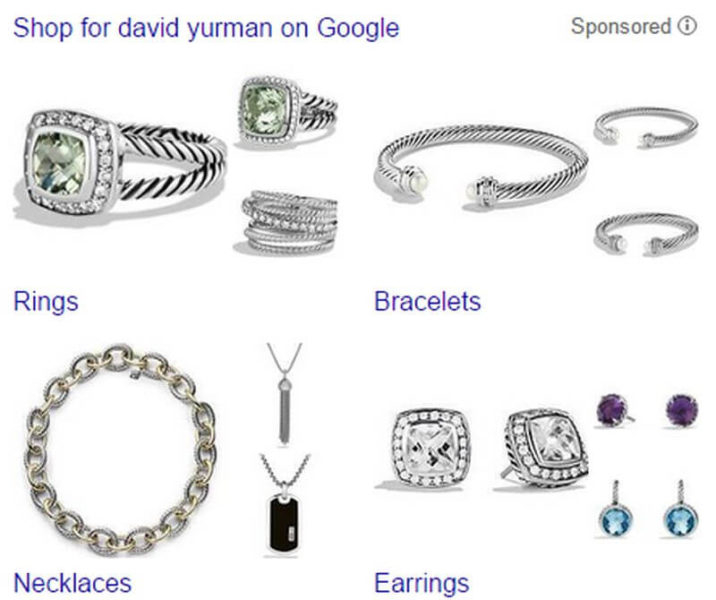In A Big Shift, Google’s Latest Ad Test Drives Users To Google Shopping, Not Advertisers’ Sites
Google is experimenting with a new format for Google Shopping ads, this time on brand searches. The example shown above showcases products from jeweler David Yurman by category — rings, bracelets, necklaces and earrings — on a search for the brand. This screen shot was sent to Search Engine Land anonymously last week, but RKG […]
Google is experimenting with a new format for Google Shopping ads, this time on brand searches. The example shown above showcases products from jeweler David Yurman by category — rings, bracelets, necklaces and earrings — on a search for the brand.
This screen shot was sent to Search Engine Land anonymously last week, but RKG has confirmed the test as well in a blog post by Senior Research Analyst, Andy Taylor, which featured a category product ad (PLA) for the clothing and housewares retailer, Anthropologie. I have not been able to replicate the test, yet, but have been able to find out a bit more about it.
One might assume that this type of ad would lead to the related category pages on the brand’s website. However, as Taylor explains, clicking on one of the categories takes users to a page on Google Shopping. For example, clicking on the Rings category in the David Yurman ad would lead to a page of David Yurman products on Google Shopping pre-filtered by “Rings”.
If a brand’s products are carried and advertised by other retailers, those listings will also appear. The results are not filtered by seller. There are product listings on the David Yurman rings category page from Nordstrom, Bloomingdale’s and other retailers that carry and advertise David Yurman products.
The user experience isn’t limited to a handful of product ads on the web search results. This view gives users a much broader view of product selection and pricing than is possible on a web SERP.
Ads Aren’t Bid-Driven
This test is interesting for a several reasons. First, it means that individual advertisers aren’t bidding to show up in this particular type of PLA. The ad is entirely advertiser neutral. I’m pretty sure that’s a first for an ad format on Google search results. (If I’m wrong, please correct me in the comments.)
Essentially it’s an ad for Google Shopping.
Real Competition Happens On Google Shopping
Second, it means that many more product ads now surface to the user, but more importantly more users are exposed to Google Shopping itself.
Today, I could probably do all of my holiday shopping entirely from PLAs and never actually visit a Google Shopping page. Sure, users can click on the “Shop for X on Google” link, but it’s easy to overlook or ignore that entree to Google Shopping. This ad test gets them there through very popular branded search queries.
Standard Google Shopping ads have been wildly successful in driving searchers to advertisers’ sites. This ad test lets Google Shopping itself benefit from the proven popularity of image-driven ads. All the better to compete against Amazon in product search and discovery.
When asked about this test, a Google spokesperson told Search Engine Land, “We are constantly experimenting
This test appears to be extremely limited at this time, but I wouldn’t be surprised to see more examples popping up in the coming weeks.
Contributing authors are invited to create content for Search Engine Land and are chosen for their expertise and contribution to the search community. Our contributors work under the oversight of the editorial staff and contributions are checked for quality and relevance to our readers. The opinions they express are their own.
Related stories

